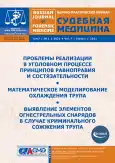On the issue of terminology in forensic medicine and its compliance with the applicable GOST standards of scissors
- 作者: Nazarova N.E.1,2, Nazarov Y.V.1,2
-
隶属关系:
- Bureau of Forensic Medical Examination
- North-Western State Medical University named aft er I.I. Mechnikov
- 期: 卷 7, 编号 1 (2021)
- 页面: 36-40
- 栏目: 协助法医
- URL: https://journals.rcsi.science/2411-8729/article/view/122413
- DOI: https://doi.org/10.17816/fm366
- ID: 122413
如何引用文章
全文:
详细
Background: The terminology used in the production of forensic medical examinations should be interpreted unambiguously by forensic medical experts, employees of investigative bodies, and doctors of other specialties and be the basis for their mutual understanding. The examination of clothing and shoes, as well as their damage, is an important part of the expert’s work. However, in the presence of forensic and forensic literature on this issue, currently increasing lack of educational and methodological publications covering modern terminological definitions is observed. During the production of forensic medical examinations of material evidence, the expert often comes across trace-forming objects (or parts of them), which is found difficult to name or describe without prejudice to an unambiguous interpretation. Attention is drawn to the fact that names of the scissors’ areas are ignored in the practice of forensic medicine. Even with the well-established concept of “scissors branch” in expert practice, different points of view are made. Aims: This study aimed to identify terminology that defines standards that ensure mutual understanding between specialists in different fields and consolidate unambiguous terms and definitions at the level of knowledge and concepts of modern science. As a result of the conducted research, authors come to the conclusion that in order to reduce the risk of different understanding of terms (including nonmedical ones), it is necessary to refer to the State Standards of the Russian Federation (GOST). As an example, this article presents the terms of the current State Standard 51268-9, wherein the main trace-forming elements of scissors are not branches but knives, and the concept of “branches” does not contain this GOST. Conclusion: Standardization and bringing forensic medical terms to the corresponding GOST standards in the production of forensic medical examinations will not only increase their quality and informativeness for investigative authorities, but also eliminate discrepancies in terminology between law enforcement officers, forensic medical experts, and doctors of other specialties.
作者简介
Natalia Nazarova
Bureau of Forensic Medical Examination; North-Western State Medical University named aft er I.I. Mechnikov
Email: na532z@yandex.ru
ORCID iD: 0000-0002-2020-0291
SPIN 代码: 6821-6095
俄罗斯联邦, Saint Petersburg
Yuriy Nazarov
Bureau of Forensic Medical Examination; North-Western State Medical University named aft er I.I. Mechnikov
编辑信件的主要联系方式.
Email: naz532@yandex.ru
ORCID iD: 0000-0002-4629-4521
SPIN 代码: 2390-8227
Scopus 作者 ID: 57137901000
Dr. Sci. (Med.)
俄罗斯联邦, Saint Petersburg参考
- Buromskiy IV, Klevno VA, Pashinyan GA. Forensic medical examination: Terms and concepts: a dictionary for lawyers and forensic medical experts. Moscow: Norma; 2006. (In Russ).
- Klevno VA, Boyko YuL, Filippov MP, Klevno RV. Medical and Forensic terminology dictionary (Basic concepts and definitions used in forensic medicine and criminology). Barnaul: Izdatel’stvo Barnaul’skogo yuridicheskogo instituta; 2003. (In Russ).
- Pashinyan GA, Zaval’nyuk AX Dictionary of forensic medical terms. Izhevsk: Expertisa; 1996. 130 р. (In Russ).
- National Standard of the Russian Federation. Judicial technical expertise. Terms and definitions. Moscow: Standartinform; 2018. (In Russ).
- Isakov VD, Babakhanyan RV, Dyskin EA, et al. Forensic description of the damage to the clothes. Educational and methodical manual. Ed. by V.D. Isakov. Saint Petersburg; 1999. 163 р. (In Russ).
- Kustanovich SD. Forensic examination of clothing damage. Moscow; 1965. (In Russ).
- Takho-Godi XM. Forensic examination of clothing. Moscow; 1971. (In Russ).
- GOST R 51268-99. Group U17. State standard of the Russian Federation. Scissors. General technical conditions. (In Russ). Available from: http://docs.cntd.ru/document/1200027241
- RMG 19-96. Recommendations on the basic principles and methods of terminology standardization. (In Russ). Available from: http://docs.cntd.ru/document/1200044770
- Kononov NV, Fetisov VA, Nazarov YuV. Problematic issues of forensic medical examination of fatal injuries caused by modern small-size water transport. Forensic medical examination. 2020;63(2):47–51. (In Russ). doi: 10.17116/sudmed20206302147
- Nazarov YuV, Tolmachev IA, Bozhchenko AP. Forensic characteristics of 18×45 and 18.5×55 mm traumatic cartridges of the OSA complex. Forensic medical examination. 2020;63(5):30–33. (In Russ). doi: 10.17116/sudmed20206305130
- Bozhchenko AP, Nazarov YuV. Definition of «aviation injury». Russian journal of forensic medicine. 2019;5(1s):59–60. (In Russ). doi: 10.19048/2411-8729-2019-5-1S-59-60
- Nazarov YuV, Bozhchenko AP. diagnostic value of diatoms In medical and forensic algological studies. Russian journal of forensic medicine. 2019;5(1s):161–162. (In Russ). doi: 10.19048/2411-8729-2019-5-1S-161-162
- Bozhchenko AP, Teplov KV, Nazarov YuV. Dermatoglyphic method for determining gender by fingerprints in the practice of identifying destroyed bodies. Russian journal of forensic medicine. 2019;5(1s): 179–180. (In Russ). doi: 10.19048/2411-8729-2019-5-1S-179-180
- Nazarova NE. To the question of the identity attributes of scissors in the study of the damage on biological tissues. Russian journal of forensic medicine. 2019;5(1s):156. (In Russ). doi: 10.19048/2411-8729-2019-5-1S-156
- Nazarova NE. On the problem of solving problems for determining the type of scissors used. Russian journal of forensic medicine. 2019;5(1s):156–157. (In Russ). doi: 10.19048/2411-8729-2019-5-1S-156-157
补充文件







